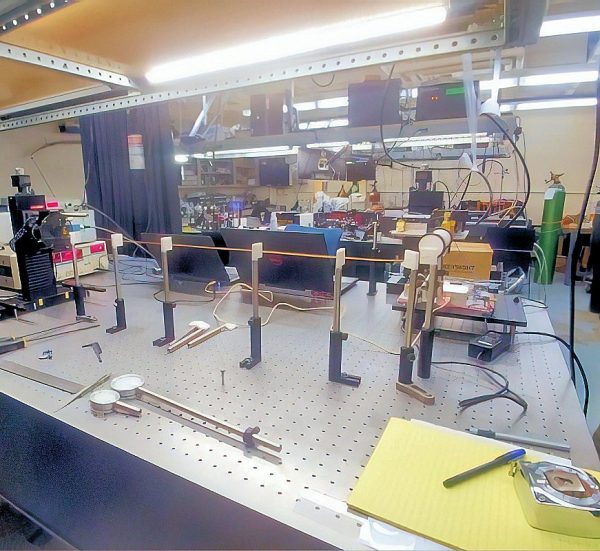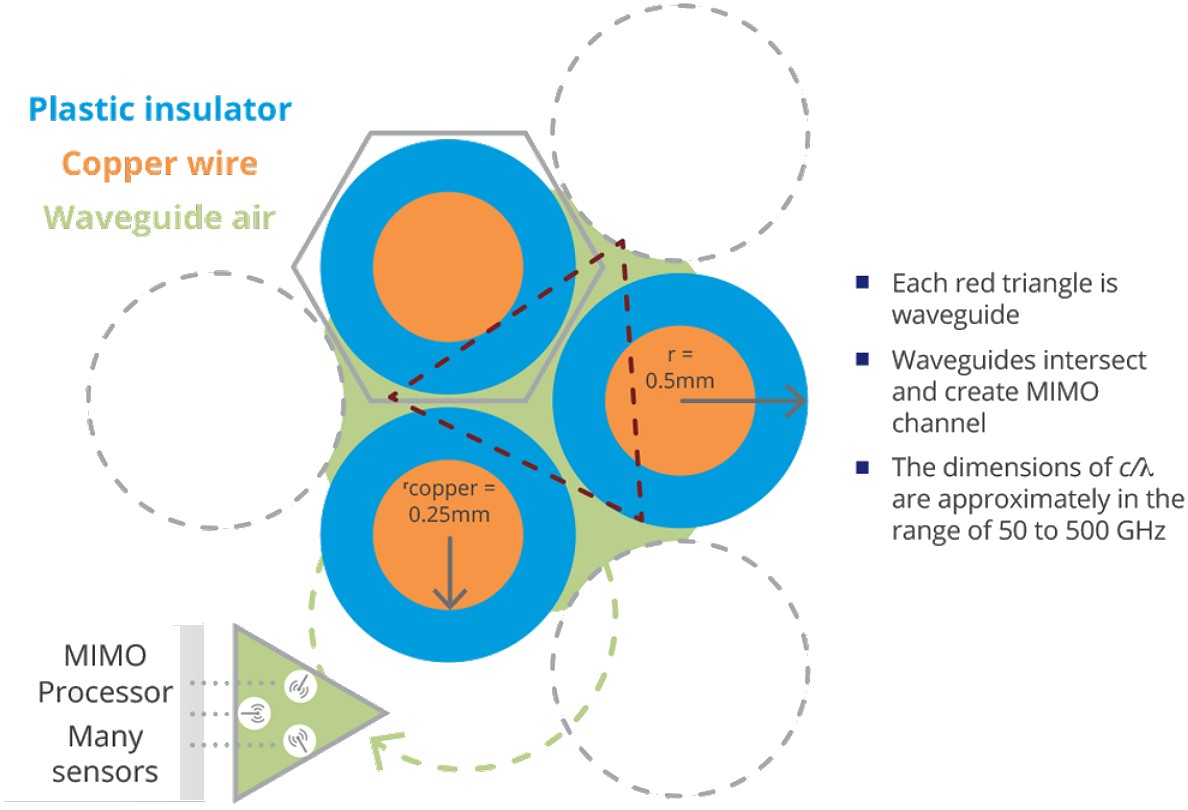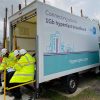Terabit DSL Copper Line Broadband Tech Begins Lab Test

Before it was only a mathematical model (here) but now, after three years, the idea of pushing broadband ISP speeds of up to 1 Terabit per second (1000000Mbps) along a traditional copper line by using previously unexploited “waveguide modes” is finally being turned into a practical lab test at Brown University (USA).
At present a lot of consumers in the UK still get their broadband using Digital Subscriber Line technologies like ADSL2+ and VDSL2 (FTTC), which send electrical signals down a tiny bit of twisted pair copper wire in order to deliver an internet connection into the home.
Stanford Professor and CEO of ASSIA, Dr John Cioffi, is one of those who helped to develop DSL and in 2017 he also proposed a new technology called Terabit DSL. However, unlike a normal DSL line, the TDSL solution adopts the radically different approach of using an existing copper wire as a mere “guide” (waveguide) to help direct a wireless broadband signal in the 100GHz+ millimeter Wave (mmW) band.
Advertisement
The original model predicted that this method could potentially deliver speeds of 1000Gbps (Gigabits per second) at distances of 100 metres, 100Gbps at 300 metres, 10Gbps at over 500 metres and possibly 1Gbps at 640-700 metres. Just for comparison, the best you could probably expect on an optimal hybrid fibre G.fast line at 300 metres, with the latest kit and amendments, is probably 500Mbps (or c.200-300Mbps on Openreach’s current setup).
The extra speed comes from the fact that above 100GHz you have a lot more spectrum frequency to play with (able to carry lots of data) and these signals can essentially “fit” between the copper wires. After that it would be possible to harness multiple-antenna style (MIMO) processing to transmit and receive the signals (modern WiFi and 5G networks also make use of MIMO).

Until now TDSL has only existed as an interesting mathematical model of what might be possible, but after a lot of work the idea is now being tested in a new lab at Brown University. “So far, the research results indicate successful transmission modes, even around bending pairs of wireless in the 200GHz range,” said a brief project update from ASSIA.
Advertisement
The fact that such speeds could be achieved, without needing to replace existing copper cables with expensive “full fibre” infrastructure, is a possible incentive for operators to explore the approach. “For example, upgrading each home with fibre to the home can cost $3000 to $4000 per home … [but TDSL] could reduce costs of building the high-speed access networks of the future by a factor of five to ten,” claimed ASSIA.
However there remains a big question mark over the real-world viability of using mmW spectrum in such a way, which is a band that can be easily disrupted (such signals usually don’t travel very far without a dense or powerful network to keep them stable). At the same time it could take years to turn TDSL into a viable commercial product and by then most of the UK will have hopefully already been upgraded to gigabit-capable FTTP.
The very fact that many countries, including the UK, are already planning to switch-off and remove their old copper networks means that TDSL may well arrive long after the main party has finished (it makes little economic sense to maintain FTTP and copper side-by-side). Nevertheless the work itself is fascinating and we’re curious to see how it develops. The following video from 2018 gives a good description of the new tech.
Mark is a professional technology writer, IT consultant and computer engineer from Dorset (England), he also founded ISPreview in 1999 and enjoys analysing the latest telecoms and broadband developments. Find me on X (Twitter), Mastodon, Facebook, BlueSky, Threads.net and Linkedin.
« Rural Broadband ISP Voneus Restructures Management Team
Google – 2 Months of FREE Stadia Pro Cloud-based Gaming »























































Great in +20 years Australia NBN might get some decent speeds.
Don’t even get me started on the NBN program. A friend of mine there say’s it makes Openreach in the UK look futuristic by comparison.
You would think they would try to fix the inherent noise problems with this technology instead of trying to ram as much bandwidth down it as possible so that people do not have to call their ISP every. single. day. A stable bidirectional flow of traffic matters the most so the cat pictures arrive straight away instead of in minutes waiting for the dsl to resync!
Barking up the wrong tree. Even if you do end up being able to shove the raw data down a copper line, you’ve still got the reliability issues of xDSL only greatly magnified. xDSL has many failure modes and simply put is not reliable enough for the networks of the future. REIN would wreck havoc on such a service.
It costs initial investment to replace copper lines with fibre but ultimately the reliability means you save large amounts of money maintaining it. Bake your fibre CPE in with a test like Sam Knows (as VM do with SH4) and you can easily prove the service is good, saving countless engineer callouts and diagnostics.
People already get annoyed with bandwidth variation as it is, who is going to accept multiple orders of magnitude in variation? I wouldn’t be happy to get 100Mbps on my “up to 10Gbps” connection.
VDSL was too late as it stands, let alone G.Fast. This is just rudely so. And I really don’t see any reason to use it for DSL. However it may have a purpose to squeeze life out of CAT5e structured cabling if incorporated into an Ethernet standard though, but not for phone lines.
I did recheck the date in this to make sure it wasn’t from 8 days ago!
It does sound like a lab only experiment. As soon as a real life cable is looped or bent and the distribution of guides changes it will become an aerial leaking signal. Or will start picking up Mrs Miggins’ microwave.
For example: Article says that the signals are transmitted over twisted pair. It shows 3 cores needed to for a guide That might be the case between cabinet and pole, and again after connector in house. There are still installations with a figure 8 bell wire from pole to house, so what happens there?
The video above covers some of your points. If it were anybody else other than Dr John Cioffi behind this then I’d probably not even take a second look, but he is one incredibly clever chap and if he thinks they know how to overcome the challenges then they probably can.
Why is the term Crosstalk yelling out in my head
Probably because that’s an inherent problem, but one they believe can be resolved by harnessing MIMO as a sort of vectoring engine.
Still trying to whip a dead donkey. May be clever people but no common sense.
And you are a professor of…
Many years ago, I attended a lecture at Sussex University where the lecturer made a very convincing case that speeds higher than 2400baud would not be achievable over copper. Boy, was he ever wrong lolz
While I have no idea whether this idea will work in the real world, I find it ridiculous that basically everybody is poo-pooing it.
Sure, fibre is more future proof but it’s also very expensive and requires construction etc.
Surely at least some of us remember when the idea of sending more than 1200bps via the voice range of the phone line was considered impossible and yet on we went, 2400bps, 4800, 9600… all the way up to a theoretical 56000 (I myself saw 54k at most – amazingly that was via a blueboxed call, admittedly on then modern switching equipment with backwards compatibility to CCITT #5).
Then we move to the ADSL age and the most we could do was 8Mbps. Oh no, actually we can do 50% better (ADSL2). Actually scratch that, we can do double (ADSL2+).
On to VDSL …. G.Fast… technical ingenuity appears to know no bounds and yet we have people who have no deep understanding of this potential future technology putting it down because their current VDSL is a bit unstable, or because “who wants up to speeds?”.
These same people would have declared claims of “we can do 8Mbps by extending the frequency range” as preposterous and claimed what’s the point, my modern sometimes drops when connected at just 28.8kbps.
Because its a Lab experiment that’s years away from any possible functioning commercial application that would be deployed over a decaying patched up network with mixed copper/aluminium cables.
Waveguide use isnt new in itself and common in radar installations, but theyre bespoke specifically designed and dimensioned and well maintained, cant say the same for the old POTs network can we. As a solution this retains all the negatives of copper.
Lovely University project yes, potential for home broadband, Not likely.
It might find a niche somewhere at the very least, only time will tell.
Dave,
Firstly, this is lab experiment/implementation. It would take years to make it to a real world product. It’s about 10-15 years too late to consider even if it were a viable product right now.
I also work in the industry, meaning I deal with the real world implementations. It doesn’t matter how intelligent someone is, all sorts of smart people come up with some great things, but real world practicalities mean they never make it out of a lab. And I can tell you that xDSL is bad enough, with relatively limited bandwidth. The amount of resources providers use to deal with the amount of DSL failures is crazy. Openreach under normal circumstances spend a lot of time sending engineers to premises to prove phone lines are within spec. Not to fix or change anything, just to prove to customers that the phone line is fine.
It’s an underlying reality of physics that copper, compared to fibre, is not a good medium to send signals down. As you use more bandwidth you get massively increased attenuation, interference, cross talk, etc. BT have been progressively shortening the length of copper with FTTC, g.fast (<500m), talk of FTTdp for a reason.
Even something like a cat 6 Ethernet cable, which is to a phone line as a phone line is to a piece of string has considerable limitations and at around the 10Gbps mark starts to require a lot of power. All because of the physics involved when you try to send large amounts of information over metal cables.
It is impossible to get any copper service anywhere near as reliable as a fibre one, unless you were to bring the fibre so close that for all intents and purposes it is a pure fibre service.
Maybe there'll be a future use for the technology, if we need to get 100Gbps over Cat 5e cabling which is expensive to replace. But the commercial pressures and realities don't support copper right now, to say anything about years down the line if this ever becomes a product.
It’ll end in tears when somebody steals the copper, kick it into touch and only use fibre wherever possible.
Oh blimey no. People fixate enough over line stats from the couple of MHz of ADSL 2+ or the 15-odd MHz of the UK’s VDSL.
Uncool as it is I actually watched the video in order to better educate myself as to the proposition here.
I can’t see it being used to reach homes however in some niches it might have its uses.
They are niches, however.
You need to get fibre within a few hundred metres of priorities to use this technology. If you can get fibre that close wireless technologies might be an option as you need a fair amount of copper to produce the really high data rates. If you have to install more copper to a property for this why not just run fibre?
This is a replacement for VDSL properties, fiber is normally within 100-600m of them. They are numerous. To access speeds in this range you need to use very high frequencies, they would be attenuated by a crow, wireless isn’t feasible. You need waveguides for these frequencies, if they can use twisted pair copper pairs I would be very impressed.
If there’s no state funding then there might be a case for the hardest 10% of properties where BT seem to think the cost of about £4000 per property is on a par with the average figures in the video. But the average cost of building fibre to properties in the UK is about an order of magnitude lower, which completely changes the economics of it. BT clearly consider there to be a ROI in unsubsidised areas.
This also means for any vendors that are looking to design equipment to support TDSL that there’ll probably be a much reduced market size outside the US because the economics support FTTP deployment.
Let’s not give BT any ideas